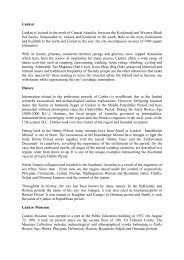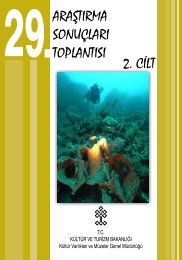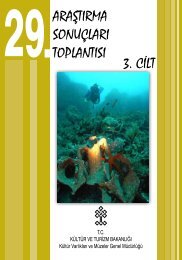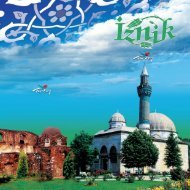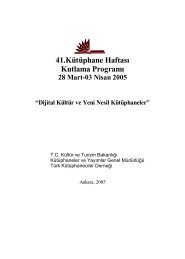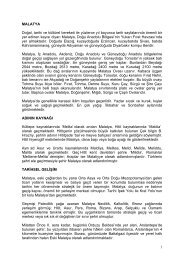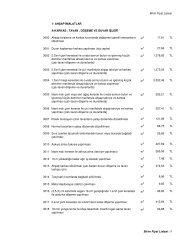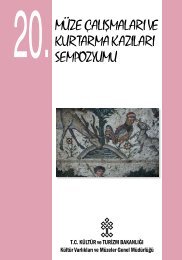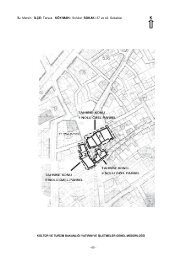Sinop brochure - Go Turkey
Sinop brochure - Go Turkey
Sinop brochure - Go Turkey
- No tags were found...
You also want an ePaper? Increase the reach of your titles
YUMPU automatically turns print PDFs into web optimized ePapers that Google loves.
Historical Heritage of <strong>Sinop</strong><strong>Sinop</strong> owes its diverse cultural richness to itsbeautiful natural harbour-perfectly shelteredand calm, a haven from the tempestuousBlack Sea. The strategic importance of<strong>Sinop</strong> Harbour brought <strong>Sinop</strong> to the foreas a centre of trade across millennia. Thecity’s strategic importance, however, lead tosuccessive conquests, and each civilizationthat made <strong>Sinop</strong> its own adorned the cityaccording to its own fashion, buildingfortresses, churches, temples, and mosquesthe harbour still lingers, although the galleysof Antiquity and the Middle Ages have beenreplaced with the modern sailing yachts andseason, <strong>Sinop</strong> Harbour is one of the mostpreferred stops for yacht tours, includingKAYRA (The Black Sea Yacht Rally), andalso hosts national sailing regattas.The cultural richness of <strong>Sinop</strong> is soextensive that almost each historical buildinghas the marks of more than one civilisation.Foremost of them all is <strong>Sinop</strong> Fortress,which has provided diverse services tovarious civilisations during its four millenniaof history. The walls of fortress demarcatethe initial area of settlement, and bearthe marks of all the civilisations that havepassed through the city. The fortress servedprimarily for defensive purposes, and duringthe reign of the Seljuk Sultans, a citadel wasadded. The builders of the citadel reused theruins of antique structures, incorporating afascinating tapestry of columns and capitalsinto the new walls. The Ottoman Sultansused the citadel as a shipyard, building3
the most powerful man-of-war of the era.In 1887 the citadel was converted into adungeon. The external walls and the sealying beyond secured the prison againstescape attempts. About the same time apublic bathhouse (hamam) was added tomeet changing needs. As in the OttomanPeriod, the citadel was used as a prisonalso during the early years of the Republic.It is now open to visitors and hosts culturalactivities.If you wish to cover the history of <strong>Sinop</strong>without too much walking, then you mustvisit the Museum of <strong>Sinop</strong>, situated atthe city centre. The Museum’s exhibitsinclude Bronze Age artefacts dating back tothird millennium BC, amphorae recoveredfrom the ships sunk in the seas around<strong>Sinop</strong>, ethnographical works of art fromthe Ottoman Period, gilded icons from the19 th century, and antique sarcophagi andstatues. built in 1335,4
and the foundations of the ancient of Serapis can be seen in the garden of theMuseum.Aslan Torunlar House, built in the early daysof the 19 th century, is one of the mansionhouses (konak) upholding the heritageof Ottoman civil architecture today andserves as the Ethnographical Museumof <strong>Sinop</strong>. The Museum is one of the mustvisitplaces in <strong>Sinop</strong> with its display ofregional ethnographical works of art as wellas its spectacular architecture, woodenornamentation and wall paintings.Although visiting the museums may help youto get the basic information on the historyand cultural heritage of <strong>Sinop</strong>, it will neverbe a substitute for seeing a work of art inits splendid and authentic surroundings.However as the Byzantine, Seljuk andOttoman buildings are dispersed to variousquarters of the city, it requires a little bitmore effort.5
The Balatlar Church, found among modernKaynak streets, is thought to have beenbuilt in the 7 th century over the remnants ofa Roman bathhouse. The only upstandingsections today are its northern and southernwalls. The frescoes on its walls and innersides of the arches, depicting Jesus Christ,the Virgin Mary and the Saints, are worth avisit, despite the blanching due to centuriesof exposure to the elements. The churchprovides a unique insight into the Byzantinepast of the city.<strong>Sinop</strong> was captured by the SeljukSultans from the Byzantines, andlater on it witnessed the foundation of. The SeljukSultans rebuilt the Fortress situated at theHarbour during this period, and they addedthe citadel. The most important Seljukbuilding in <strong>Sinop</strong> is the built during the reign of Alaaddin Keykubat.6
The , which is situatedat the intersection of Sakarya and AlaaddinKeykubat streets, is the oldest Seljukbuilding in <strong>Sinop</strong>, and it was built in 1214just after the conquest of the city by SeljukSultanate. However it was damaged duringthe mid-century raids. In 1268 it wasrepaired by who also built the Pervane Madrasah, andlater on it has been renovated and altered inplan mosque has a courtyard surrounded byhigh walls. The built in the corner ofthese walls belongs to the period. The sarcophagi that may be seen inof Turkish stone carving. The nearby is thought to havebeen built together with the mosque. situated oppositethe Alaaddin Mosque, was built in 1262 byMuineddin Süleyman Pervane in order tocommemorate the deliverance of the city7
from its enemies. The marble portal of themasonry of the period. The rooms, formerlyused for tutoring, now house handicrafts.Locally woven fabric, calling on centuries oftradition, can be purchased there and willenable you to carry your <strong>Sinop</strong> memorieshome.situated next to thePervane Madrasah was built for GhaziÇelebi, the grandson of MuineddinSüleyman Pervane, and its entranceis through the Madrasah. A marblesarcophagus in the Tomb carries an epitaphstating that Ghazi Çelebi died in 1322, andthe tomb dates to that period.Hill, and while the tomb there was built forpeople it is known as the Bilal. According to the epitaph of the marblesarcophagus in the Tomb it was built in1297, and it is a building commemoratingthe Seljuk Period. Cezayirli is also from the Seljuk Period,however, due to the extensive repairsundertaken in 1876 and 1898 it has lost itsoriginal features.The , which are also knowkept <strong>Sinop</strong> until the conquest by Ottomanfor a century and half, the Tomb in thecourtyard of Alaaddin Mosque, HatunlarSaray Mosque and Fetih Baba Masjid werebuilt in <strong>Sinop</strong>.9
The situated in theimportant buildings of this period. It was1353, and its name was taken from FetihMuhammed Baba whose grave is located tothe south of the Masjid. Another importantis the which was built14 th century detailing of the mihrab.<strong>Sinop</strong> was incorporated into the Ottomanlands by Sultan Mehmet the Conqueror inOttoman legacy are the <strong>Sinop</strong> Houses thathave survived to date within the historicaltexture of streets. When you walk along thestreets of the area, which was declared asa protected site of historical importance,you will feel as if transported to the Ottoman<strong>Sinop</strong> through a time tunnel., built in 1651, isone of the oldest Ottoman mosques. It issituated on the Sakarya Street, togetherwith the which hasa distinctive wooden minaret, although itis from the late period of Ottomans. Witha short walk you can visit both. Anotherbuilding belonging to the Ottoman Period isthe which is situated onTuzcular Street.The , built in10
another Ottoman building. It commemoratesone of the most tragic incidents of theRusso-Ottoman war of the mid 19 th century.Pasha Bastion, built during the Russo-Ottoman War to defend the coastal area,and situated on the 2 nd kilometre of the roadfrom <strong>Sinop</strong> to Karakum, will be of interestto military history enthusiasts. The siteis now like an open air museum, and theunderground bunkers and storage facilitieshave been renovated for use as a restaurantand café. It makes a superb outing.12One of the most important buildings of <strong>Sinop</strong>is the , which isfact that Mustafa Kemal Atatürk launchedthe campaign to replace the Arabic alphabetwith the Latin one on November 24 th , 1928at the garden of this school. That reform wasone of the most important attempts to bring<strong>Turkey</strong> in line with contemporary western
civilisations. To this day 24 November iscommemorated as the Teachers’ Day in<strong>Turkey</strong> to honour the memory of headmasterAtatürk teaching the new alphabet.While the history of <strong>Sinop</strong> goes that wayback, there are not many historical buildingsin the city centre. In order to explore thehistory of the city into antiquity, you must getout and visit the counties.meters long tunnel dug into the rocks at theSülüklü Lake, believed to be a water conduit.The tunnel has a cylindrical air vent, 1.514The Boyabat County of <strong>Sinop</strong> Provincehas changed hands several timesbetween Romans, Byzantines, Seljuks,is the Fortress built over the rocky outcrop
of the highest point crowning Boyabat.From the Fortress you will have a bird’seye view over the county. The tunnelsand the underground town, dating back tothe Roman Period, are reached throughhundreds of rock hewn steps and are themost interesting parts of the Fortress. Inexamples of wooden civil architecture,the buildings cited in the literature as theBoyabat Houses.We recommend you to visit Rock Cut Tombof Salar Village while in Boyabat. The tombdates back to the 7 th century BC, and thepillar capitals were sculpted as lion-headsthe struggle between a man and a lion.The Tomb is fully hewn into a rock face andsituated at Salar Village, about 15 kilometresfrom Boyabat.15
The Durak Caravanserai which was builtby Süleyman Pervane, whose buildings in<strong>Sinop</strong> city were covered above, in 1246,lends its name to the County.The Caravanserai is situated on the tradingroute leading to <strong>Sinop</strong> which has themost important port of Black Sea, and theinscription at the entrance portal indicatesthat the Caravanserai was built on the ordersof Sultan Keyhüsrev. The Caravanseraihad 13 rooms, a masjid, bathhouse, andan inn encircling a courtyard. However, thebathhouse has failed to reach our day. Thethe county was built in 1395, according to itsinscription.Another important ruin within the boundariesAmbarkaya, dated 7 th century BC, which is(ancient River Halys) and its tributarya sheer and craggy rock face overlookingthe valley below. There are also steps,caverns which are thought to be utilised asstorage facilities, and tunnels cut into therock face. Although abundant terracottapieces found about the vicinity indicatethat there was a human settlement at thisarea, no visible ruins remain. Watching thepanoramic valley at sundown is fascinating.The , which is situatedin Köhler Village, has similar features. Theanimals, and it was estimated to be built in7 th century BC.16
Diogenes of <strong>Sinop</strong> and Alexander theGreatThe famous philosopher of Antiquity,to the city, was born in <strong>Sinop</strong> in 412 BC.Hence he is referred to in the antiquesources as Diogenes of <strong>Sinop</strong>e.can be reached through an austere life andhe lived in a tub. Accepting the thoughtof the cynics, the philosopher argued thatthe way of living most harmonious with thenature is the way that animals live.The most frequently told story of theGreat. Alexander the Great visited thephilosopher who, despite his fame, livedin austere poverty, thought by some to beyou know who am I?”, asked Alexander.“You are the slave of my own slave,”slave and you are captured by the world!”Alexander was delighted with this reply andasked him to name whatever he wished, aswith his philosophy,“Stand a little lessbetween me and thesun.”19
<strong>Sinop</strong>, the Land of Natural Beauty<strong>Sinop</strong> is a must-visit, not only because ofits historical heritage, but also for its naturalbeauty. The grounds of <strong>Sinop</strong> were thebed of various civilisations in its historyof six millennia, and the city’s importancestretched beyond its strategically importantharbour. The fertility and natural beautyof its lands will astonish the visitor, who,to explore all beauty spots, should spareas a minimum of a couple of days. Shoreswhich were embroidered by the waves,and thick forests formed by age old treesare enchanted places, as if they had justleaped out of fairy tales and were awaitingyour exploration. Any hike in the mountainswith vistas of tall trees, waterfalls andvalleys adorned with rare plants will be verypleasurable. For those who do not feel athome in the hotel rooms, <strong>Sinop</strong> is a focusof attraction with the campsites it can offerwhere some unbelievable experiences andviews make you visit again and again withto enjoy the generous natureeither through trekking orhorseback riding are theAkliman and Hamsilos Bay.White Harbour,northernmost tip of<strong>Sinop</strong> Province andprotected naturalhabitat site, unspoilt by humanconstruction. The mountains21
ordering the Black Sea embrace all hues offorest green and occasionally allowed sea tonarrow coves extending deep into the land.This is the best place to escape the rush andhullabaloo of the cities. You may enjoy aboats along the coast. The Lighthouseand its environs is a protected wildlife areafor deer, pheasant and gazelle. The Village set on the 15 th kilometre of the roadtrees and pristine nature, is the choicestpicnic area for the inhabitants of <strong>Sinop</strong>.23
26The Hamsilos Bay is a place you cannotmiss when you visit <strong>Sinop</strong>, and it is justnorth of Akliman. It is one of the rare fjordsfound in <strong>Turkey</strong>, and as it is enclosed fromthe three aspects with high lands coveredwith thick forests, it seems as if a lake ratherthen an extension of Black Sea. You mayhire boats for a pleasure trip, visit caves andwith a rod and tackle, or visit ancient ruins.If you enjoy solitude you may prefer to swimhere instead of beaches close to the city.
which is justhalf an hour drive away from the centre of<strong>Sinop</strong> is another natural wonder, and thelake and its environs have been declareda Protected Natural Area. While you walkin the forest, do not wonder if you seefreely wandering horses. They are freeroamingferal horses. The lake itself is a birdwatching centre. Also some endangeredspices such as lynx and roe deer roam thistruly arcadian reserve.<strong>Sinop</strong> where the sea and land areinterwoven stands in counterpoint to themisguided belief that “in the Black Seacoast there are not many beaches suitablefor swimming”. Its sandy beaches aremore than match even for the famousMediterranean beaches. If you wish youcan swim at beaches along the city shoresor beaches along the shores where seameets the forests. One of the choicest spotclose to the city centre is sands are believed to help rheumatic aches,and other similar ailments. The 7-kilometrelongAkliman Beach is one of the longestbeaches of Black Sea coast. As there is noresort about, it is the choicest spot for thosewho like solitude and tranquillity.A rare natural formation can be foundkilometres away from Boyabat. Here thea very patient and talented artist using aprecision tool. Actually these basalt rocksare not shaped by human hand at all. Theslow millennia. The Waterfall of Çukurhanother natural wonders carved by time.31
32The Erfelek County is famousfor its waterfalls. The groupof whichand types of falls, is a uniquefeature of <strong>Sinop</strong>. Watchingthe picturesque waterfallsand listening to the cascadingwater’s music will providethe utmost relaxation andcontentment to cleanse yourmind. To explore the other fallswhich are not considered part ofreal explorer’s spirit and legs tomanage the trekking.
34The County provides quiteinteresting places for nature lovers such asWhite Lake and . Thepristine nature enclosing the Akgöl enchantsany visitor with its panorama, and rendersthe beauty of lake unique. At that mostpopular excursion spot of <strong>Sinop</strong> you mayhire rowing boats. The in themeters long, the last part of this distanceof nature you must follow the road to AkgölBoyabat at the junction on the 17 th kilometre.
<strong>Sinop</strong> has numerous caves and caverns.One of them is BuzlukCavekilometres north ofdomed caverns, createdby karstic dissolution,naturally formed ice isfound at any time. Thecave entrance has itsown charm with severalmineral water springs,and provides a muchhighly popular excursionspot.35
38Local Cuisine<strong>Sinop</strong> providesmany uniquedishes for thosewho love toexplore newtastes.Like every townalong the Black Sea coast,<strong>Sinop</strong>’s dishes will impress you with tastestasty seafood all along the Black Sea coastfrom anchovy (hamsilocal nets are prepared in numerous waysand served. The anchovy is the staplefood of Black Sea, and <strong>Sinop</strong>’s baked riceiçli tava) is oneof the most famous local dishes. You mayhave this dish at the boat restaurants you
nokuliçi etli hamurkatlamamamalikalt hasudasrkkeataktak helvasezme39
Shoppingkeep your <strong>Sinop</strong> memories alive. Amongthe possibilities one comes to mind atonce - the hand-made model ships thatare a speciality of this seaport city. Otherperfect gift or memento options include linenready made items prepared with them, aswell as çemer (a locally woven fabric),knitted throws mahrama (macramé), saddlebags and shoulder bags fashioned withold carpets (heye), woven matting (kilim)and embroidered woolly socks prepared in41
Must-Does before Returning42 In <strong>Sinop</strong>,the land of natural beauty, the prime spotsto experience the nature are Akliman,from the crowds and humdrum rush of thecity, visit those areas and spend at leasta couple of days camping in the sylvangroves. Everycorner of <strong>Sinop</strong>, where the nature and seasare generous, is the home of yet anothertaste. , , , gourmets who are interested in the localfood. TheBlack Sea also means the upland pastures() with their outstanding natural beautywhich are used during the summer months.The important high pastures are Mehmetli,
Alpine-postcard picturesque beauty ofthese upland pastures are famous not onlyfor their nature, but also for the traditionalarchitecture, annual festivals, scores ofand endemic fauna. The upland pasturesof the Black Sea host the most impressivetrekking routes as well as beautiful campingsites. The nomadic peoples ( living inthe hills are renowned for their hospitality,and ready to help whenever you need.They would be glad to accommodate you.However be careful about the season totravel to upland pastures. Apart from highsummer season, continuous rain wouldmake climbing to the upland pastures very If youwish to maintain your memoriesbeyond photos, buy some giftand memorabilia from the localhandcrafts vendors, such asmodel ships, or (macramé), (alocally woven fabric) andembroidery.43
The Black SeaThe Black Sea Region takes its name fromthe sea lying all along the northern shoresof <strong>Turkey</strong> - however its rich geographyvery deep blue. Maybe its name refers tothis phenomenon. Maybe it took its “black”name from the laments that have beenlives amidst the tempestuouswaves. Green is abundant inevery crevice of the Black Seashore. It is in love with the blue itlongs to meet. Therefore, it reachesinto the sea, and rises high up to themountain peaks to meet the bluesky.For centuries the people of theBlack Sea has lived sheltered bythe green, and earned a livelihoodfrom the blue. In its traditionalarchitecture, the timber houses givetheir backs to the hills, and turned theirfaces to the sometimes calm, but oftentempestuous waves of the Black Sea.always genial and welcoming.The Black Sea is a gift of natureto the humanity presented withinthe melancholic love story of greenand blue. It has been the host ofseveral civilisations that have admiredits wind sculpted shores, and its hillsblossoming every season. Its natureand sea enriched its cuisine. TheBlack Sea is a place where thewhat they seek among the ruins ofAntiquity, and those nature-lovers, in45
the splendour of the environment. The BlackSea is also indispensable for the adrenalinjunkies with its areas suitable for adventuresports, and skiing resorts.The Black Sea is a place of legendswhere reality and dreams are merged.The Amazons settled here. The Argonautschasing the <strong>Go</strong>lden Fleece passed acrossthis tempestuous sea. The water engulfedAtlantis, the most developed city of Antiquity,rushed from Black Sea. The stubborn herotravelled around the perimeter of the BlackSea just for the sake of a wager.As the rest of Anatolian landmass, theBlack Sea has the stamps of millennia ofcivilisations. Roman, Byzantine, Seljuk andOttoman monuments follow in succession,but also live together side by side. If youwish you can trace them in the museum, orexplore them with the zeal and enjoyment ofan explorer.47
TransportationBy Sea:You can reach <strong>Sinop</strong> by boats that weeks.Harbour:Sea Department:By Air:The airport in <strong>Sinop</strong> is 8 km away from thecity centre. From the airport, it is easy to goto the city centre by taxi or mini buses called.Airport: It is possible to get <strong>Sinop</strong> by road fromeverywhere in <strong>Turkey</strong>. The Bus Station issituated in the city centre.Bus Station:48
Useful Contact DetailsProvincial Directorate of Culture andTourismYeni Mah. Okulak Sok.Tel: (+90 368) 261 30 23Fax: (+90 368) 261 48 68Pervane MadrasahTel: (+90 368) 260 12 58Historic <strong>Sinop</strong> PrisonTel: (+90 368) 260 48 20<strong>Sinop</strong> MuseumOkullar Caddesi No: 2Tel: (+90 368) 261 19 75Fax: (+90 368) 261 61 63 (Open exceptMonday between 08.00-17.00)<strong>Sinop</strong> Etnography MuseumTel: (+90 368) 260 23 07Fax: (+90 368) 261 61 63Historic <strong>Sinop</strong> PrisonTel: (+90 368) 260 48 20<strong>Go</strong>vernorshipTel: (+90 368) 261 82 85MunicipalityTel: (+90 368) 261 18 44HospitalTel: (+90 368) 271 55 70PoliceTel: (+90 368) 261 17 7050GendarmerieTel: (+90 368) 261 18 40
Cultural Heritage is FragileThe world’s cultural heritage is like a bigpuzzle. Each monument, each object, isan irreplaceable part of the overall picturewhich gives us insight into our origins, ourdevelopment and our lives today. It helps usto understand and appreciate other cultures.Each discovery, each new interpretation addsto the puzzle and makes the picture clearer.We must ensure the protection of every singlepiece today, so that future generations mayhave the opportunities to enjoy the puzzle.Many people are not aware that our culturalheritage is under stress from natural disasterssuch as earthquakes and floods, and fromslower acting processes such as pollutionor human actions. Even the most innocentgestures such as collecting ancient piecesof pottery or mosaics as souvenirs have adestructive impact if repeated by thousands.Touching an object of stone, metal or textileleaves traces of grease, acid or sweat on itssurface. Climbing a monument wears downthe structure underneath and can dismantle it.Writing or engraving names inflicts permanentdamage. Strolling around narrow crowdedplaces with bulky bags or backpacks mightknock over an object or scratch a muralpainting and ruin it. There are countless waysin which one can unknowingly contribute to thedestruction of cultural heritage.In 2020 there will be 1.6 billion visitors per yearworldwide. Let us raise awareness of this issueso that we may join together to protect andenjoy the diversity and richness of our culturalheritage.53
T.R. MINISTRY OF CULTURE AND TOURISMGeneral Directorate of Information©www.goturkey.comwww.kulturturizm.gov.trTextRedactionGraphic DesignPhotosPrintAnkara, 2011For Free Distribution


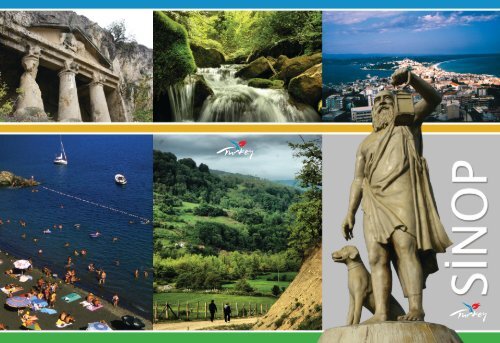
![11. Türk Arkeoloji ve Etnografya Dergisi [2011] - kulturvarliklari.gov.tr](https://img.yumpu.com/50970752/1/182x260/11-turk-arkeoloji-ve-etnografya-dergisi-2011-kulturvarliklarigovtr.jpg?quality=85)
